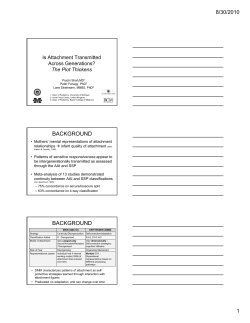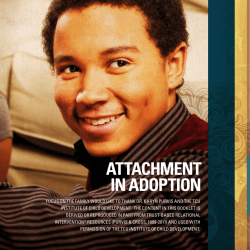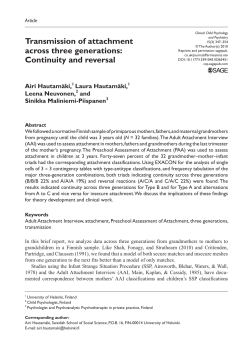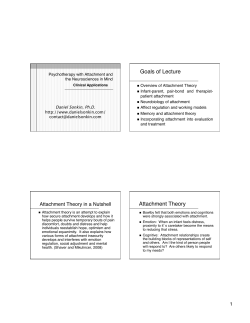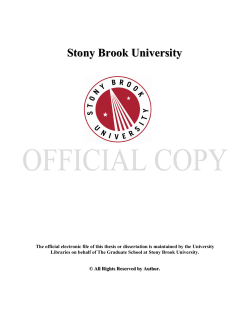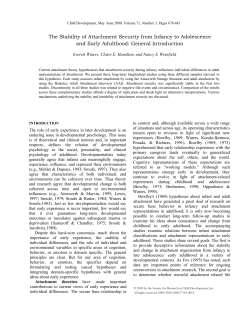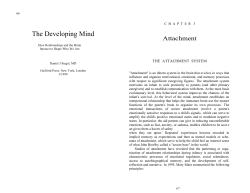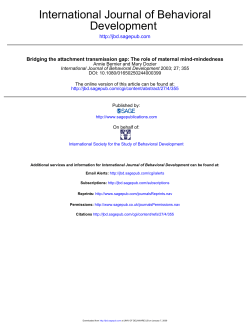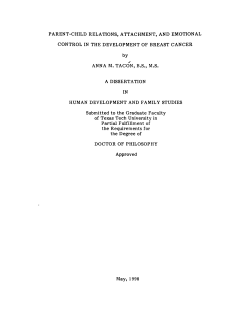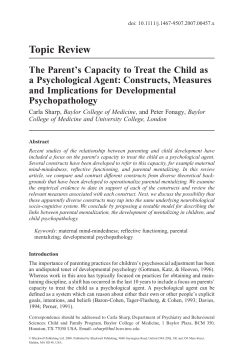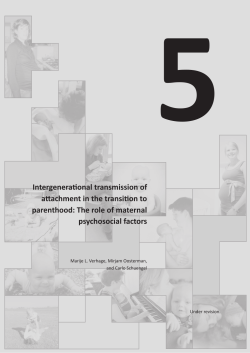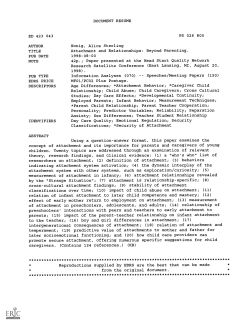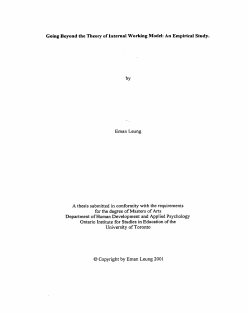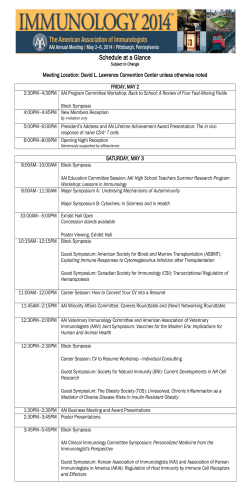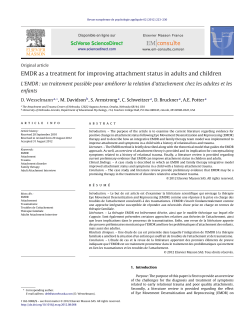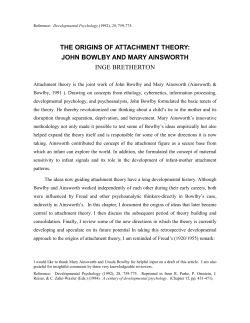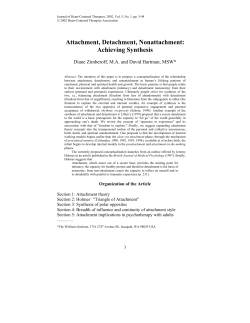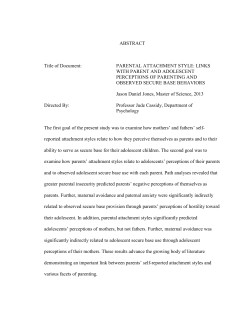
Document 13518
The Journal of Genetic Psychology, 755(4), 471-486 The Adult Attachment Interview and Questionnaires for Attachment Style, Temperament, and Memories of Parental Behavior MARCEL A. DE HAAS MARIAN J. BAKERMANS-KRANENBURG MARINUS H. VAN IJZENDOORN Center for Child and Family Studie s Leiden University, The Netherlands ABSTRACT. Relations between Adult Attachment Interview (AAI) outcomes and data from questionnaires on attachment style, temperament,and memories of parental caregiving behavior were investigated to examine theoretical and methodological specificity of the AAI. The participants were 83 mothers of 1-year-olds. No differences between the three AAI classifications (autonomous, dismissing, or preoccupied) were found. Correlations between scales yielded few significant relations, with the exception of strong relations between some AAI scales for experiences and selfreported memories of parental behavior. The self-report questionnaires for attachment style and memories of parental behavior were therefore found to be not suitable for obtaining Information about attachment working models äs assessed by the AAI. Furthermore, attachment working models appear independent of temperament. ALTHOUGH BOWLBY (1969) conceived of attachment theory äs covering life-span personality development, attachment research has focused mainly on the first years of life. The introduction of a Standard observation procedure for the assessment of attachment relationships between babies and their attachment figures (the Strange Situation: Ainsworth, Blehar, Waters, & Wall, 1978) led to an explosion of research in that area. However, halfway through the 1980s, George, Kaplan, and Main (1985) developed the Adult Attachment Interview (AAI), which enabled researchers to assess attachment representations in adolescence and adulthood äs well. In this interview, respondents reflect on their childhood attachment experiences and evaluate possible impacts of these experiences on their own personality and behavior. 471 472 The Journal of Genetic Psychology Parallel to the attachment classifications in childhood, the AAI coding system (Main & Goldwyn, 1985/1991) identifies secure and insecure patterns of adult attachment on the basis of three main classifications: autonomous, preoccupied, and dismissing. These classifications reflect differences in mental representations that are based on differences in the organization of attachment experiences. To stress the dynamic nature of these mental representations, Bowlby (1969, p. 80) called them the "internal working models." Internal working models are defined äs sets of conscious and unconscious rules for the organization of attachment Information and for accessing that Information (Main, Kaplan, & Cassidy, 1985). There is an important distinction between attachment experiences (primarily with parents) that have probably taken place in the past and the way in which these experiences are represented (the state of mind with respect to attachment). The AAI coding system provides measures for both aspects. First, the system contains rating scales for judging if, and to what extent, childhood experiences were probably characterized by parental love, rejection, neglect, pressure to achieve, and role reversal. Second, the representation of experiences is assessed by nine rating scales that discriminate between the autonomous, preoccupied, and dismissing AAI classifications (Main & Goldwyn, 1985/1991). Examples of such state-of-mind scales are the extent to which parents are idealized, the extent of anger toward the parents, and the coherence of the interview. The AAI classifications primarily reflect state of mind with respect to attachment. First, autonomous attachment refers to emotional openness toward attachment experiences. During the interview autonomous respondents provide balanced and coherent pictures of attachment experiences. Negative aspects of the relationship with parents are not withheld. Second, the dismissing pattern of attachment is characterized by an attitude of devaluing attachment. This means, for example, that one's own attachment history is presented in a more positive light than it probably actually was, or that the impact of attachment experiences on personality and child rearing is denied (Main & Goldwyn, 1985/1991). Contradictions between positive evaluations of the relationship with the parents and, at the same time, the inability to This study was supportedby a PIONEER grantfrom the Netherlands Organization for Scientific Research (NWO, Grant PCS 59-256) to Marinus H. van IJzendoorn. We gratefully acknowledge the help of Corine de Ruiter, Marianne de Wolff, Stella van Rijsoort, Hylda Zwart- Woudstra, and Mariska Zwinkels in collecting and coding dato. We also thank Francisco Bijkerk, Bart Bosman, Dineke den Boer, Ciska Dijkstra, Bertilla van den Bovenkamp, and Adinda van Veenfor transcribing the interviews. Address correspondence to Marinus H. van IJzendoorn, Center for Child and Family Studies, Leiden University, P. O. Box 9555, NL-2300 RB Leiden, The Netherlands. De Haas, Bakermans-Kranenburg, & van Uzendoorn 473 recall positive events, give rise to the impression that the respondent is idealizing the parents. Finally, the preoccupied pattern of insecure attachment characterizes a person who is still enmeshed in negative childhood experiences. The preoccupied respondent often manifests anger against parents, and events are described in disorderly and incoherently ways. The AAI classification seems to be independent of intelligence, autobiographic memory, or social desirability (Bakermans-Kranenburg & Van Uzendoorn, 1993; Crowell et al., 1993; Sagi et al., 1994). In several studies (for a review, see Van Uzendoorn, 1992) an impressive correspondence was found between AAI classifications of parents and the quality of attachment relationships with their babies (Strange Situation classifications; Ainsworth et al., 1978). These studies show that autonomous parents mostly have secure relationships with their children, whereas children are often attached ambivalently to preoccupied parents and attached avoidantly to dismissing parents. For a substantial part this transmission of attachment patterns can be explained by differences in sensitive responsiveness. In general, autonomous adults respond in a more sensitive way to Signals from their children (e.g., Crowell & Feldman, 1988; Grossmann, Fremmer-Bombik, Rudolph, & Grossmann, 1988; for a review, see Van IJzendoorn, 1992). Apparently an open and balanced organization of attachment experiences provides an adequate matrix for openness toward children's attachment Signals. Purpose of This Study The Adult Attachment Interview (AAI) is a time-consuming measure. Administering the interview takes about l hr; the audiotape must be transcribed verbatim; and coding the interview takes at least 4 hr. Coding can be done reliably only after extensive training. At least two questions should be asked considering the AAI: First, can the AAI be replaced by a less timeconsuming Instrument? Second, what is the specificity of the AAI compared with other measures of personality? The first question is especially important for big research projects in which it is almost impossible to use the AAI. Thus, because the AAI focuses on experiences with parents, one could reasonably suggest the use of questionnaires about behavior of parents during a person's childhood. However, we already pointed at the importance of idealization and coherence for the identification of attachment patterns. For that reason we doubt the usefulness of questionnaires in this respect. The second question concerns implications of attachment representations for personality. Although the AAI does not provide measures of personality or social competence, theoretically the internal working model of attachment may affect personality to some degree (Bowlby, 1973). This impact could, according to Bowlby, be ascribed to the image of the seif in terms 474 The Journal of Genetic Psychology of the feeling that one is loved and valued. This self-image directs one's behavior in interactions with others. Securely attached children have positive images of themselves and, therefore, differ from insecurely attached children in social competence. Several studies confirm this hypothesis for children (e.g., Fagot, 1993; Sroufe, 1983; Waters, Wippman, & Sroufe, 1979) and for adolescents (Kobak & Sceery, 1988). Whether these results may be generalized to working models of adults is still unclear. Personality covers a broad domain, and certain aspects of personality (e.g., temperament), are said to be inherited, stable, and thus little affected by experiences (Buss & Plomin, 1984). Because temperament is seen äs an important brick in the building of personality, it is necessary to rule out that the internal working model of attachment is just a matter of temperament. Although an interaction between temperament and attachment is plausible (see also Vaughn et al., 1992), a large overlap between attachment and temperament would cause one to question the specificity of the concept and measure of the internal working model of attachment. According to Hazan and Shaver (1987), attachment experiences should find expression in one's attachment style, that is, one's way of forming close relationships with other adults. A secure attachment style would mean that a person gets involved in close relationships easily, has few problems with mutual dependency, and is not afraid of being abandoned or becoming too close. An anxious avoidant attachment would appear from uncomfortable feelings in close relationships, whereas an anxious ambivalent attachment would appear from one partner's clinging to the other partner because of fear of losing him or her. Attachment style is assessed in this study by a questionnaire (Hazan & Shaver, 1987). In the present study we focused on relations between AAI classifications and rating scales, on the one hand, and questionnaires for attachment styles, temperament, and memories of parental behavior, on the other hand. Presuming that temperament and attachment are mutually influencing, but nonetheless different constructs, we expected that temperament would show at most a moderate association with the AAI. From a theoretical point of view attachment style should, however, show at least a modest relation with attachment representations and experiences. In addition, we expected that the AAI scales for attachment experiences would show some convergence with memories of parental behavior äs assessed by questionnaires. This convergence in fact concerns the agreement between the respondent and the AAI coder about the respondent's childhood experiences. Method Participants In this study (part of a larger project on the intergenerational transmission of attachment; Bakermans-Kranenburg & Van Uzendoorn, 1993) 83 Dutch De Haas, Bakermans-Kranenburg, & van Uzendoorn 475 mothers participated. The mothers' mean age was 27 years 4 months; the youngest mother was 19, and the oldest mother was 33 years old (SD — 2.6). On average, the mothers did work out of home for 6.7 hr per week (SD = 8.5); the maximum was 24 hr per week. All lived together with a partner in Leiden or its neighboring villages and had a first-born child of 12 months of age (43 sons and 40 daughters). The mean educational level was 3.7 (SD = .90) on a scale ranging from l (less than 6 years of schooling) to 6 (at least 16 years of schooling). The participants visited the laboratory twice, with a 2-month interval. During the first visit they were interviewed with the AAI and completed questionnaires about temperament, attachment style, and memories of parental behavior. During the second visit the AAI was again administered, and the participants were given the same questionnaires about memories of parental behavior to be completed at home. Except for testretest reliability, no use was made of the data collected at the second time of measurement. Measures The Adult Attachment Interview (AAI). The AAI is a semistructured interview that is used to evoke descriptions of relationships with parents in childhood, specific memories, and descriptions of current relationships with parents. The Interviews took about l hr and were transcribed verbatim. Then the protocols were coded according to scales for attachment experiences (e.g., loving, rejecting, role reversing) and for state of mind with respect to attachment (idealization, anger, recall, coherence, metacognition, derogation, fear of loss, and some scales for unresolved loss or other trauma that are not included in this report). Agreement between two coders was satisfactory for the most important scales concerning the childhood experiences with the mother. The mean intercoder agreement (r) for the six scales that are most important and that were used in this study (loved versus unloved by mother, rejection by mother, role reversal with mother, idealization of mother, anger toward mother, and coherence of transcript) was .78 (ränge = .65-. 90; n = 16). In addition, the Interviews were classified into one of the three adult attachment categories: autonomous (F), preoccupied (E), and dismissing (Ds) attachment. Percentage of agreement on 16 transcripts was 81% (κ = .72); the test-retest reliability for the whole sample was 78% (κ = .63). Memories of maternal behavior. Participants' memories of their mothers' behavior were assessed with two questionnaires. The first questionnaire, the 'Egna Minnen Beträffende Uppfostran' (EMBU), was designed in Sweden by Perris, Jacobsson, Lindström, Von Knorring, and Perris (1980) to assess memories of parental rearing behavior. Items are scored on a 4-point scale 476 The Journal of Genetic Psychology separately for each parent. The EMBU contains four subscales: rejecting (26 items), emotional warmth (18 items), overprotecting (16 items), and favoring subject (4 items). Arindell, Emmelkamp, Brilman, and Monsma (1983) reported good reliability and validity for the EMBU in the Netherlands. In our study, test-retest coefficients (r) between .65 and .88 were found, and internal consistency (a) ranged from .65 to .94. The second questionnaire, the Parental Adjective Scale (PAS), was developed on the basis of the adjectives with which the participants described their parents (based on the AAI coding system). The PAS consists of 34 adjectives describing the participant's mother in relation to himself or herseif äs a child. On a 4-point rating scale, respondents were asked to indicate their agreement with the descriptions. Three a priori scales—Loving, Rejecting, and Incompetence—containing 10 adjectives each, could be derived (testretest reliability ranged from .72 to .87, and internal consistency ranged from .69 to .90). A fourth scale (Overprotection) was not reliable. Because of the overlap between the PAS scales for Loving and Rejecting and the EMBU scales for Emotional Warmth and Rejecting, the only PAS scale we used was Incompetence. Adult attachment styles. Hazan and Shaver's (1987) measure for Adult attachment styles was designed from a translation of Ainsworth et al.'s (1978) descriptions of infants' attachment classifications (ambivalent, secure, and avoidant) into terms appropriate for adult love relationships. A fourth description was added later (Mayseless, 1990) to cover the disorganized/disoriented infant-attachment category (Main & Solomon, 1986). The participants were asked to indicate which description best described their feelings. Four continuous 7-point scales were added to indicate how strongly respondents identified with each one of the four descriptions. Because analyses showed that the description of the disorganized pattern could not be distinguished from the ambivalent description, the four scales were reduced to the original three scales. Hazan and Shaver (1987) reported satisfactory psychometric qualities of their self-report Instrument. Temperament. Temperament of the participants was assessed on the dimensions of Emotionality, Activity, and Sociability (EAS; Buss & Plomin, 1984). Emotionality was further divided into three subscales; Fear, Anger, and Distress. Individual differences on these dimensions are proposed to have genetic roots, to be manifest at a very young age, and to affect subsequent personality development (Buss et al., 1984). The EAS dimensions seem to be related to the five-factor model of personality (the Big Five), but the structure of this relation is not obvious (John, 1990). Internal consistency (a) of the five scales (Fear, Anger, Distress, Activity, and Sociability) ranged in our study from .57 to .67. This moderate reliability might be due to the small number of items De Haas, Bakermans-Kranenburg, & van Uzendoorn 477 per scale (the EAS questionnaire consists of only 20 five-point items). For test-retest reliabilities, Buss et al. (1984) reported correlations between .75 and .85. Background variables. To examine potential effects of third variables on associations, we included four relevant background variables. First, performance IQ was assessed with Raven's Standard Progressive Matrices (Raven, 1958), which was validated in the Netherlands by Van der Giesen (1957) and Van Weeren (1968). Second, to assess the participants' tendency to provide socially desirable answers, we used a shortened version of the MarloweCrowne social desirability scale (Crowne & Marlowe, 1960), which was validated in the Netherlands by Nederhof (1981). This shortened version consisted of 10 Statements concerning attitudes and traits, each with two response categories (true or false). Seven items loaded on the first principal component, and this one-dimensional scale showed a moderate reliability (a = .67). Educational level of the respondent was assessed according to Dutch Standards on a scale ranging from has not completed elementary school (1) to university degree (6). In addition, the participant's age was added to this set of background variables. Results Associations between measures and background variables (educational level, social desirability, intelligence, and age) were examined. Significant differences between AAI classifications were found only for age, F(2, 80) = 4.72, p = .01. The mean age of the autonomous group was somewhat higher than that of both insecure groups (see also Bakermans-Kranenburg & Van Uzendoorn, 1993). Product-moment correlations between the 19 scales and the four background variables were calculated. Because these calculations resulted in 76 correlation coefficients, a Bonferroni correction was applied, leading to an alpha level of .01. According to this criterion, only 11 (14%) of the 76 correlations seemed to be significant, with a mean correlation (r) of .32. The significant correlations were equally spread over background variables and scales. These results made us decide not to apply any correction for effects of background variables in subsequent analyses. AAI Classifications and Scales Forty-six (55%) Interviews were classified äs autonomous, 20 (24%) äs dismissing, and 17 (20%) äs preoccupied. This distribution approximately equals distributions that were found in other samples from "normal" populations (Van Uzendoorn & Bakermans-Kranenburg, in press). The AAI classifications were strongly related to AAI scales for state of mind with respect to 478 The Journal of Genetic Psychology attachment (this result was also estabhshed m the study of Fonagy, Steele, & Steele, 1991) One-way multivanate analyses of vanance (MANOVAs), with the three state-of-mmd scales äs dependent variables, yielded a significant mam effect, Pillai's = 79, approximate F(6, 154) = 16 8,/? < 001 All three umvanate F tests were also significant (see Table l, ANOVA) Coherence of transcnpt showed the strengest association with the AAI classifications, F(2, 80) = 39 5, p < 001, and anger the weakest association, F(2, 78) = 11 4, p < 001 The scores of the three AAI categones were different on the AAI expenence scales äs well, but to a somewhat lesser extent than the state-of-mmd scales The one-way MANOVA with the expenence scales äs dependent variables yielded a Pillai's = 58, approximate F(6, 156) = 10 6, p < 001 The umvanate F tests also seemed significant (see Table l, ANOVA) However, state of mind and expenences were not independent from each other (see Table 2) For example, the coherence of transcnpt showed a quite strong positive relationship with lovmg expenences (r = 60, p < 001) and a negative relation with rejectmg expenences (r = — 47, p < 001) We exammed whether these correlations between state-of-mmd and expenence scales could account for the differences among the AAI classifiTABLE l Mean Scale Score Ratings and Standard Deviations of Adult Attachment Classification (AAI) Scales, Grouped by AAI Classiflcation AAI Classification Scale Probable expenenceb Lovmg Rejectmg Role reversmg State of mmd Ideahzmgb Current angerb Coherence of transcnpt jt j L.'S M SD M SD M SD ANOVA F 28 51 08 15 50 27 15 15 38 36 13 22 18 6*** 13 2*** 17 10 24 12 39 16 13 6*** 12 j*** 46 15 25 11 27 10 20 8*** 10 8*** 19 19 14 07 37 27 11 4*** 9 0*** 33 09 55 13 35 08 39 g*** 20 3*** ANCOVA' F 30 28 Note Ds = dismissmg (7V = 20), F = autonomous (7V = 46), E = preoccupied (7V = 17) a All three state-of-mmd scales arc covanates when probable expenence scales are dependent variables, and vice versa b Concernmg mother of participant **> < 001 De Haas, Bakermans-Kranenburg, & van IJzendoorn 479 cations for the experience scales. For that purpose, the aforementioned MANOVAs were performed with the following covariates: First, in the MANOVA with the experience scales äs dependent variables, the three state-ofmind scales were included äs covariates. These covariates caused a reduction in the main effect, but this effect remained significant, Pillai's = .30, approximate F(6, 148) = 4.5,p < .001. However, univariate Ftests for loving experiences and rejecting experiences (see Table l, analysis of covariance [ANCOVA]) seemed no longer significant, F(2, 75) = 3.0, p = .06, F(2, 75) = 2.8,/? = .07, respectively. The univariate Ftest for role-reversing experiences remained significant, F(2, 75) = 12.1, p < .001. The other way around, that is, MANOVA with state-of-mind scales äs dependent variables and experience scales äs covariates, yielded a reduced but significant main effect äs well, Pillai's = .60, approximate F(6, 148) = 10.7,/? < .001. However, group differences on the separate state-of-mind scales also remained significant (see Table l, ANCOVA). These results confirm that AAI classifications primarily reflect mental representations of attachment, in particular, the coherence of the interview. AAI and Memories of Parental Behavior ANOVAs were performed to examine relations between AAI classifications and the five scales for participants' memories of their mothers' parental behavior, derived from the questionnaires. No significant group differences beTABLE 2 Correlations Between Adult Attachment Interview Scales Probable experience·' Scale Rejecting Probable experience·1 Loving -.84*** Rejecting — Role reversing State-of-mind Idealizing·' Current anger1 Coherence of transcript State of mind Role reversing Idealizing'' Current anger·1 Coherence of transcript .10 -.16 — -.38*** .38*** -.21 -.28* .27* .14 .60*** _ 47*** .05 -.30** -.58*** -.27* •'Concerning molher of participant. *p < .05, **p < .01, ***p < .001 (two-tailed). — — 480 The Journal of Genetic Psychology TABLE 3 Mean Scale-Score Ratings and Standard Deviations of Attachment Style, Temperament, and Memories of Maternal Behavior, Grouped by AAI Classiflcation AAI Classificaüon Ds Questionnaire Memories of mother Rejecüon Warmth Overprotection Favormg subject Incompetence Attachment style Avoidant Ambivalent Secure Temperament Sociability Activity Fear Anger Distress M SD M SD M SD 7^(2,80) 34 56 35 6 15 47 108 56 22 47 34 58 36 6 14 65 77 58 15 40 39 53 37 7 16 142 130 64 28 49 263 210 043 1 00 071 08 13 65 37 50 39 21 45 17 12 21 36 24 45 21 14 21 33 25 41 19 13 21 040 056 021 67 58 81 31 26 23 26 18 77 80 69 62 73 35 29 20 24 19 71 83 64 91 64 32 26 22 22 18 75 62 81 56 71 250 140 100 075 006 09 26 90 48 95 Note Ds = dismissmg (N = 20), F = autonomous (N = 46), E = preoccupied (N = 17) tween the autonomous, preoccupied, and dismissmg participants were found (see Table 3) This result might be mterpreted äs a lack of association between state of mmd with respect to attachment and actual memones of attachment expenences Nonetheless, we found correlations between AAI state-of-mmd scales and AAI expenence scales (Table 2) The picture becomes more clear when we examine the correlations between AAI scales and scales for memones of parental behavior (see Table 4, Bonferrom-corrected alpha level) While AAI classifications did not show any sigmficant association with memones of parental behavior, AAI scales did Correlations were found between the AAI scale for loving expenences, on the one hand, and memones of emotional warmth (r = 53, p < 001) and memones of rejection (r = - 38, p < 001), on the other hand (see Table 4) For the AAI scale for rejectmg expenences, these correlations (r) were — 57 (p < 001) and 43 (p < 001), respectively Likewise, the AAI scales for state of mmd showed some relations with memones of parental behavior (see Table 4) These relations, however, concerned only the scale for anger toward mother, which correlated with memo- De Haas, Bakeimans-Kranenburg, & van IJzendoorn 481 TABLE 4 Product-Moment Correlations Between Adult Attachment Interview Scales and Attachment Style, Temperament, and Memories of Maternal Behavior Questionnaire Memones of mother Rejection Warmth Overprotection Favormg subject Incompetence Attachment style Avoidant Ambivalent Secure Temperament Sociabihty Activity Fear Anger Distress State of mmd Probable expenence ' Current Coherence Role Lovmg Rejectmg reversmg Ideahzation1 anger1 transcnpt 59***t - 42***c 08 43*** - 38*** 53*** - 57*** 12 -08 07 04 11 -28 06 - 16 - 01 -07 27 -05 16 -06 - 18 14 13 -01 18 -01 - 14 - 14 00 22 07 02 -06 21 -22 18 00 - 16 -07 16 00 -02 00 12 24 12 -25 -04 -08 -26 00 29* 04 08 03 -03 07 -03 03 - 11 09 -02 01 - 12 - 15 06 33** -01 16 20 13 - 13 09 17 -05 21 13 Note Bonferromzed sigmficance levels *01,** 002,*** 0002 (two-tailed) Mother of subject bAfter the effect of rejectmg expenences has been partialled out, / = 54, p < 001 c After the effect of lovmg expenences has been partialled out, r = — 33,p < 01 nes of rejection (r = 59, p < 001) and memones of emotional warmth (r = — 42, p < 001) After partiallmg out the mutual correlations with rejectmg expenences (m the case of memones of rejection) and lovmg expenences (m the case of memones of emotional warmth), these two correlations remamed significant (r = 54, p < 001, and r - - 33, p < 01, respectively) Thus, the relation between anger toward mother and reported memones of warmth or rejection cannot be explamed by the mutual relations with expenences However, anger toward mother seemed less important m determintng the AAI classification (compared with the two other state-of-mmd scales, see Table 1) As stated before, the coherence of the transcnpt was more important m this respect, and this scale did not have any relation with memones of parental behavior (see Table 4) In summary, AAI scales for expenences converged partly with the self-reported memones of emotional warmth and 482 The Journal oj Genetic Psychology rejection, whereas the associations with the state-of-mind scales were less prominent. Adult Attachment, Attachment Style, and Temperament Significant associations between AAI classifications on the one band, and attachment styles and temperament on the other hand, were absent (see Table 3). Only sociability showed a slight trend, F(2, 80) = 2.5, p = .09, in favor of the autonomous participants. Likewise, the state-of-mind scales showed hardly any association with temperament and no association at all with attachment style. Only anger toward mother seemed to be positively related with a fearful temperament (r = .33, p < .001). The same applied to the AAI scales for experiences (see Table 4): Of these scales, only rejecting experiences correlated with a fearful temperament (r = .29, p < .01). Discussion Attachment theory postulates that internal working models of attachment are constructed from attachment experiences and that they concern interrelated mental models of seif and social life (Bowlby, 1973). The AAI is used to try to assess to what extent these experiences were probably characterized by emotional warmth, rejection, neglect, pressure to achieve, or role reversal, and, more important, the state of mind of the respondent regarding these attachment experiences. Individual differences in state of mind with respect to attachment are supposed to spring from differences in the mental organization of Information relevant to attachment. This organization becomes apparent by the way in which respondents reflect on childhood attachment experiences during the AAI, and coherence of discourse is one of the most important indicators of an open and balanced organization. Our study shows that AAI scales reflecting the form rather than the content of the transcribed interview do not converge with self-reported memories of parental behavior (in one's own childhood). Thus, self-report Instruments, such äs the EMBU and the PAS, seem to yield little or no Information about the state-of-mind dimension of attachment. The internal working model of attachment might indeed reflect deeper representations of attachment. This notion was suggested by Bretherton (1990), who distinguished Information that is easily accessible, on the one hand, and Information that is difficult to access to consciousness, on the other hand. The easily accessible Information is supposed to be verbally transmitted by parents, whereas the less accessible Information is supposed to be based on the original experiences. This latter kind of Information may not become accessible unless a clinically oriented in-depth interview such äs the AAI is conducted. However, longitudinal research is needed to decide to what extent adults' states of mind with respect to attachment are rooted in their actual past attachment experi- De Haas, Bakermans-Kranenburg, & van IJzendoorn 483 ences. In Germany (Grossmann et al., 1988), äs well äs in the United States (Main, Kaplan, & Cassidy, 1985), samples of children who were studied from their Ist year of life will soon reach adulthood. Only then will it be possible to connect actual attachment experiences in childhood to attachment representations in adulthood. Neither attachment experiences nor state of mind regarding attachment seems to be expressed in one's attachment style; we did not find relations between the AAI and the Hazan and Shaver (1987) attachment styles. Similar results were found in the Crowell et al. (1993) study. Compared with the AAI, the attachment style questionnaire seems to yield a rather general personality measure. Strong relations were found between attachment styles and work orientation (Hazan & Shaver, 1990), religious orientation (Kirckpatrick & Shaver, 1992), and the "Big Five" personality traits (Shaver & Brennan, 1992). Furthermore, the methodological differences between the AAI and the attachment-style measure are immense. As stated before, administering and coding the AAI implies labor-intensive and time-consuming procedures. Depth is obtained because of the semistructured nature of the interview. Subjectivity (biases such äs social desirability) is minimalized by focusing on coherence and contradictions in the interview, rather than on the content. The attachment style questionnaire is an Instrument that is administered and coded very easily. Respondents are supposed to choose out of three or four short descriptions the attachment style that fits their ideas best. This way, classification and ratings might measure only the easily and directly accessible perception of the respondent. For research in the future it will be interesting to examine whether a less direct and more open measure for attachment style (e.g., an AAI-like interview) leads to different results. Finally, we found, äs expected, almost no association among AAI scales and temperament. Moreover, no temperament differences were found between the three patterns of attachment—autonomous, preoccupied, and dismissing. The contribution of temperament to the construction of internal working models of attachment has been a topic of debate for many years. Vaughn et al. (1992) combined several studies on the relation between temperament and attachment in children. One of the important conclusions was, "Although our data provide evidence of overlap between temperament and attachment domains, the degree of association is not high enough to suggest more than a modest redundancy" (p. 469). Furthermore, when there seemed to be a relation between temperament and attachment, the mother was usually the informant for both variables. Our results might be interpreted äs support for the hypothesis that temperament and attachment are two relatively independent constructs in adulthood äs well. However, the methodological differences (self-report questionnaire versus interview) should also be taken into account. Nevertheless, it is clear that the EAS temperament dimensions, assessed by self-report methods, provide hardly 484 The Journal of Genetic Psychology any Information about the state of mind with respect to attachment (and vice versa). The Adult Attachment Interview has been developed to identify differences in parents' attachment representations that could account for differences in the quality of the attachment relationships with their children. In behavioral terms, several studies pointed at the importance of sensitive responsiveness for the development of a secure relationship with the child. Determinants of differences in sensitive responsiveness were searched for in the Personality of the parents (Ainsworth, 1979; Lamb & Easterbrooks, 1981; Skinner, 1985), in particular in those aspects that were supposed to build on the parents' own developmental histories (e.g., Belsky, 1984). The AAI enables researchers of attachment to focus on a specific aspect of personality, that is, on the state of mind with respect to attachment (working models). Different states of mind seem to predict (a) differences in sensitive responsiveness and (b) the quality of the attachment relationship with their own children. Our study showed that attachment representations are not associated with attachment style or with temperament, and we concluded that in future research on attachment representations, the current available selfreport questionnaires should not be the first choice. REFERENCES Ainsworth, M. D. S. (1979). Attachment äs related to mother-infant interaction. In J. S. Rosenblatt, R. A. Hinde, C. Beer, & M. Busnel (Eds.), Advances in the study ofbehavior (Vol. 9, pp. 2-51). San Diego: Academic Press. Ainsworth, M. D. S., Blehar, M. C., Waters, E., & Wall, S. (1978). Patterns of attachment: A psychological study of the stränge Situation. Hillsdale, NJ: Erlbaum. Arindell, W. A., Emmelkamp, P. M. G., Brilman, E., & Monsma, A. (1983). Psychometric evaluation of an inventory for assessment of parental rearing practices. A Dutch form of the EMBU. Acta Psychiatrica Scandinavica, 67, 163-177. Bakermans-Kranenburg, M. I, & Van Uzendoorn, M. H. (1993). A psychometric study of the Adult Attachment Interview: Reliability and discriminant validity. Developmental Psychology, 29, 870-879. Belsky, J. (1984). The determinants of parenting: A process model. Child Development, 55, 83-96. Bowlby, J. (1969). Attachment andloss: Vol. 1. Attachment. New York: Basic. Bowlby, J. (1973). Attachment and loss: Vol. 2. Separation. New York: Basic. Bretherton, I. (1990). Commimication patterns, internal working models, and the intergenerational transmission of attachment relationships. Infant Mental Health Journal, 11, 237-251. Buss, A. H., & Plomin, R. (1984). Temperament: Early developingpersonality traits. Hillsdale, NJ: Erlbaum. Crowell, J. A., & Feldman, S. S. (1988). Mothers' internal models of relationships and children's behavioral Status: A study of mother-child interaction. Child Development, 59, 1273-1285. Crowell, J. A., Waters, E., Treboux, D., Posada, G., O'Conner, E., Colon-Downs, C., De Haas, Bakermans-Kranenburg, & van IJzendoorn 485 Felder, O., Fleischman, M., Gao, Y, Golby, B., Lay, K.-L., & Pan, H. (1993, March). Validity of the Adult Attachment Interview: Does it measure what it should? Poster Symposium presented at the biennial meeting of the Society for Research in Child Development, New Orleans, LA. Crowne, D. P, & Marlowe, D. (1960). A new scale of social desirability independent of psychopathology. Journal of Consulting Psychology, 24, 349-354. Fagot, B. (1993, March). Attachment classification äs a predictor ofpeer relationships at age 7. Paper presented at the biennial meeting of the Society for Research in Child Development, New Orleans, LA. Fonagy, R, Steele, H., & Steele, M. (1991). Maternal representations of attachment during pregnancy predict the organization of infant-mother attachment at one year of age. Child Development, 62, 891-895. George, C, Kaplan, N, & Main, M. (1985). Adult Attachment Interview. Unpublished manuscript, University of California, Berkeley. Grossmann, K., Fremmer-Bombik, E., Rudolph, J., & Grossmann, K. E. (1988). Maternal attachment representations äs related to patterns of infant-mother attachment and maternal care during the first year. In R. A. Hinde & I Stevenson-Hinde (Eds.), Relations between relationships within families (pp. 241-260). Oxford, UK: Clarendon Press. Hazan, C., & Shaver, P. (1987). Romantic love conceptualized äs an attachment process. Journal of Personality and Social Psychology, 52, 511-524. Hazan, C., & Shaver, P. (1990). Love and work: An attachment-theoretical perspective. Journal of Personality and Social Psychology, 59, 270-280. John, O. P. (1990). The "Big Five" factor taxonomy: Dimensions of personality in the natural language and in questionnaires. In L. A. Pervin (Ed.), Handbook of personality: Theory and research (pp. 66-100). New York: Guilford Press. Kirckpatrick, L. A., & Shaver, P. R. (1992). An attachment-theoretical approach to romantic love and religious belief. Personality and Social Psychology Bulletin, 18, 266-275. Kobak, R. R., & Sceery, A. (1988). Attachment in late adolescence: Working models, affect regulation and representation of seif and others. Child Development, 59, 135-146. Lamb, M. E., & Easterbrooks, M. A. (1981). Individual differences in parental sensitivity: Origins, components, and consequences. In M. E. Lamb & L. R. Sherrod (Eds.), Infant social cognition: Empirical and theoretical considerations (pp. 127153). Hillsdale, NJ: Erlbaum. Main, M., & Goldwyn, R. (1985/1991). Adult attachment scoring and classification system. Unpublished manuscript, University of California, Berkeley. Main, M., Kaplan, N., & Cassidy, J. (1985). Security in infancy, childhood and adulthood: A move to the level of representation. In I. Bretherton & E. Waters (Eds.), Growing points of attachment: Theory and research (pp. 66-104) (Monographs of the Society for Research in Child Development, 50, 1-2, Serial no. 209). Chicago: University of Chicago Press. Main, M., & Solomon, J. (1986). Discovery of a new, insecure-disorganized/disoriented attachment pattern. In M. Yogman & T. B. Brazelton (Eds.), Affective development in infancy (pp. 95-124). Norwood, NY: Ablex Press. Mayseless, O. (1990, July). Attachment patterns of adults: New findings and a new scale. Paper presented at the Fifth International Conference on Personal Relationships, Oxford, England. Nederhof, A. J. (1981). Beter onderzoek. Bestrijding van foutenbronnen in sociaalwetenschappelijk onderzoek [How to diminish biases in social research]. 's- 486 The Journal of Genetic Psychology Gravenhage, The Netherlands: Vuga. Perris, C., Jacobsson, L., Lindström, H., Von Knorring, L., & Perris, H. (1980). Development of a new inventory for assessing memories of parental rearing behaviour. Acta Psychiatrica Scandinavica, 6l, 265-274. Raven, J. C. (1958). Standard progressive matrices: Sets A, B, C, D, and E. London: Lewis. Sagi, A., Van Uzendoorn, M. H., Scharf, M., Koren-Karie, N., Joels, T., & Mayseless, O. (1994). Stability and discriminant validity of the Adult Attachment Interview: A psychometric study in young Israeli adults. Developmental Psychology, 30, 9881000. Shaver, P. R., & Brennan, K. A. (1992). Attachment styles and the "Big Five" personality traits: Their connections with each other and with romantic relationship outcomes. Personality and Social Psychology Bulletin, 18, 536-545. Skinner, E. A. (1985). Determinants of mother sensitive and contingent-responsive behavior: The role of childrearing beliefs and socioeconomic Status. In I. Sigel (Ed.), Parental helief-systems: The psychological consequences for children (pp. 51-82). Hillsdale, NJ: Erlbaum. Sroufe, L. A. (1983). Infant-care-giver attachment and patterns of adaptation in the preschool: The roots of competence and maladaptation. In M. Perlmutter (Ed.), Development andpolicy concerning children with specialneeds. Minnesota Symposium on Child Psychology (Vol. 16, pp. 41-83). Hillsdale, NJ: Erlbaum. Van der Giesen, R. W. (1957). Enkele aspecten van het probleem der predictie in de Psychologie, speciaal met het oog op de selectie van militair personeel [Some aspects of the problem of prediction in psychology, especially in consideration of selecting rnilitary staff]. Lisse, The Netherlands: Swets en Zeitlinger. Van Uzendoorn, M. H. (1992). Intergenerational transmission of parenting: A review of studies in non-clinical populations. Developmental Review, 12, 76-99. Van Uzendoorn, M. H., & Bakermans-Kranenburg, M. J. (in press). Attachment representations in mothers, fathers, adolescents, and clinical groups: A meta-analytical search for normative data. Journal of Consulting & Clinical Psychology. Van Weeren, P. (1968). Uitkomsten van het psychologisch onderzoek omtrent milieu, schoolkcuze en schoolgeschiktheid in Amsterdam, Twente, Friesland en NoordBrabant [Results from psychological research on social class, school choice, and school adequacy in Adam etc.]. In F. van Heek (Ed.), Het verborgen talent (pp. 126-151). Meppel, The Netherlands: Boom. Vaughn, B. E., Stevenson-Hinde, J., Waters, E., Kotsaftis, A., Lefever, G. B., Shouldice, A., Trudel, M., & Belsky, J. (1992). Attachment security and temperament in infancy and early childhood: Some conceptual clarifications. Developmental Psychology, 28, 463-473. Waters, E., Wippman, J., & Sroufe, L. A. (1979). Attachment, positive affect, and competence in the peer group: Two studies in construct validation. Child Development, 50, 821-829. Received June 4, 1994
© Copyright 2026
